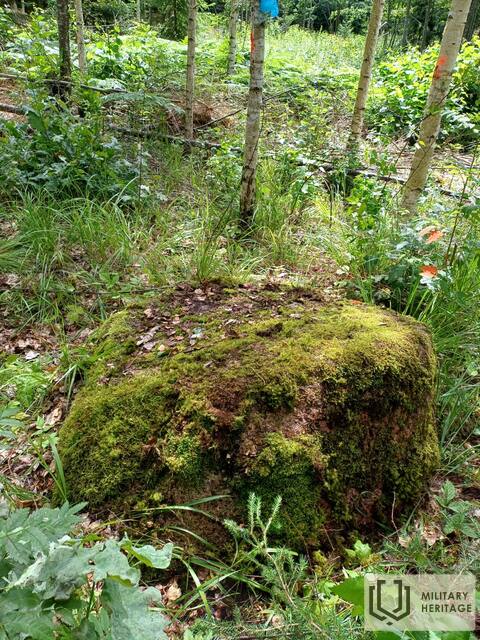P. Prauliņš's national partisan group bunker site
Bunker


 179
179




The site of P. Prauliņš' bunker is located in the 4th section of Vidsala block 99, Kalna parish. The stone on which P. Prauliņš sat has been preserved.
P. Prauliņš's (1911-1949) partisan group in the Kalna forest in the Birži parish was destroyed on May 16, 1949, during an operation by the Ministry of State Security of the Latvian SSR, in which military units also participated. The forest brothers had set up a bunker with perimeter defense, which was well camouflaged and was located at an undetermined height in a swampy area. The partisans fiercely resisted the Cheka troops for at least 40 minutes, but the entire group fell: Pēteris Prauliņš, Artūrs Bružuks, Jānis Kalvāns, Edvīns Slikšāns and Francis Skromanis. The shot forest brothers were thrown near the parish house, but their remains were later buried in nearby gravel pits. Irma Bružuka was seriously injured, who was taken prisoner and died on May 17 in Jēkabpils Hospital. She was buried outside the cemetery, but when the cemetery was expanded after Latvia regained its independence, a monument was placed on her grave.
The Birži parish national partisan group of Pēteris Prauliņš was part of the group led by Mārtiņš Pokļevinskis (1902-1951). The group carried out several partisan actions, in which Soviet collaborators were punished and food and property of the economic institutions of the occupation authorities were requisitioned. The partisans of P. Prauliņš' group did not observe sufficient conspiracy, many persons visited their settlement, which created an opportunity for betrayal. The lack of military experience was one of the shortcomings of the partisan armed movement.
A memorial stone to the partisans of P. Prauliņš' group in Kalna parish was consecrated in November 1998.
Used sources and references:
H. Bruņinieks. Cheating Death. Riga: Latvian Media, 2022, pp. 227-229, 242.
The Unknown War. The Struggle of Latvian National Partisans Against the Soviet Occupiers 1944-1956. 1st ed. Riga: Domas sūks, 2010, pp. 326-327.
Related timeline
Related stories
Selija's forest brother settlement in the Sūpe swamp
The Sūpes swamp is associated with the sites of national partisan settlements and battles, which were formed through the interaction of people and places. It is described in the ballad of the exiled Latvian writer Alberts Eglītis about the events in his native Sūpes swamp “In Moss and Mud” - a tribute to the Sūpes swamp partisans:
… “In 1945, as autumn glowed in the swamp -
On Pokļevinskis' birthday, Lieljānis shares at dinner:
Beer fermented in willows,
The Romulans worship butter,
I dry my mother's caraway bread,
Dried ham in March cuts,
And Stuchka's onions,
Ildzeniece cheese.
Rooms in resinous walls
And lightning has struck hearts,
And in eleven souls languish-
"The roots that have rotted in the ground..."
This interpretation of the past, with its post-World War II events, included human testimonies, expressions of spirit, and value systems. It recalls the popular support for the national partisans, whom the occupying power could not defeat so easily.






